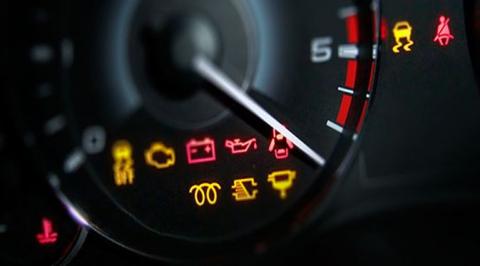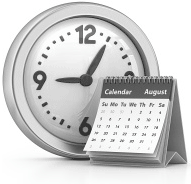
As our vehicles get more sophisticated, it seems as if car manufacturers put more and more warning indicators on our dashes. Soon, it can seem overwhelming and hard to keep up with what they all mean. In this article we'll focus on a few of the more common warning indicators and what they mean.
Symbols vary a bit from model to model, but if you have one of these symbols light up it does NOT mean that maintenance is due. This is indicating an actual failure affecting the running of your car. You may not feel any difference but the car's computer sees a failure and is alerting you. It could be something as simple as a loose gas cap or something more significant failing in the engine itself. Don't wait...get it checked out soon.
 This indicator comes in yellow (amber) or red. Red generally means a loss of engine oil pressure. This should be taken very seriously as a loss of pressure can cause engine damage! Stop the car and tow it in. The amber indicator generally means low oil level. Check the oil level at the dipstick (if equipped) and top off as needed and generally you should be able to drive it to the shop to check for a leak or consumption of oil.
This indicator comes in yellow (amber) or red. Red generally means a loss of engine oil pressure. This should be taken very seriously as a loss of pressure can cause engine damage! Stop the car and tow it in. The amber indicator generally means low oil level. Check the oil level at the dipstick (if equipped) and top off as needed and generally you should be able to drive it to the shop to check for a leak or consumption of oil.
 This also comes in yellow or red. This indicates that the coolant level sensor is not seeing sufficient coolant in the expansion tank or radiator. Due to potential physical harm of checking a warm or hot engine, I recommend only checking the engine when it is completely cold and having a professional shop pressure test the cooling system for leaks.
This also comes in yellow or red. This indicates that the coolant level sensor is not seeing sufficient coolant in the expansion tank or radiator. Due to potential physical harm of checking a warm or hot engine, I recommend only checking the engine when it is completely cold and having a professional shop pressure test the cooling system for leaks.
 This is a low tire pressure/flat tire indicator. Not all vehicles have this feature. If this indicator comes on, it generally means that one or more of your tires has less tire pressure than the others or is now flat. Pull over gently and check your tire pressures. Even a difference of a few pounds of pressure can cause the light to come on. Add air as needed and reset the indicator as listed in your owner's manual.
This is a low tire pressure/flat tire indicator. Not all vehicles have this feature. If this indicator comes on, it generally means that one or more of your tires has less tire pressure than the others or is now flat. Pull over gently and check your tire pressures. Even a difference of a few pounds of pressure can cause the light to come on. Add air as needed and reset the indicator as listed in your owner's manual.
 This is a brake pad wear indicator. It normally means it's time for a brake job. That means measure the rotors with a brake caliper...not visually...to see if rotors can be turned or will need to be replaced.
This is a brake pad wear indicator. It normally means it's time for a brake job. That means measure the rotors with a brake caliper...not visually...to see if rotors can be turned or will need to be replaced.
There are many other symbols and warnings that each car can have depending on their model and options. Consult your owner's manual or feel free to call us or come by and we can help you out. Understanding the warning signs can save you time and money by catching a problem early.

 Sign-up today for service interval reminders such as: oil & filter, brakes, tires, and more... These parts are designed to wear & need to be replaced before any major damage occurs. We can help.
Sign-up today for service interval reminders such as: oil & filter, brakes, tires, and more... These parts are designed to wear & need to be replaced before any major damage occurs. We can help.